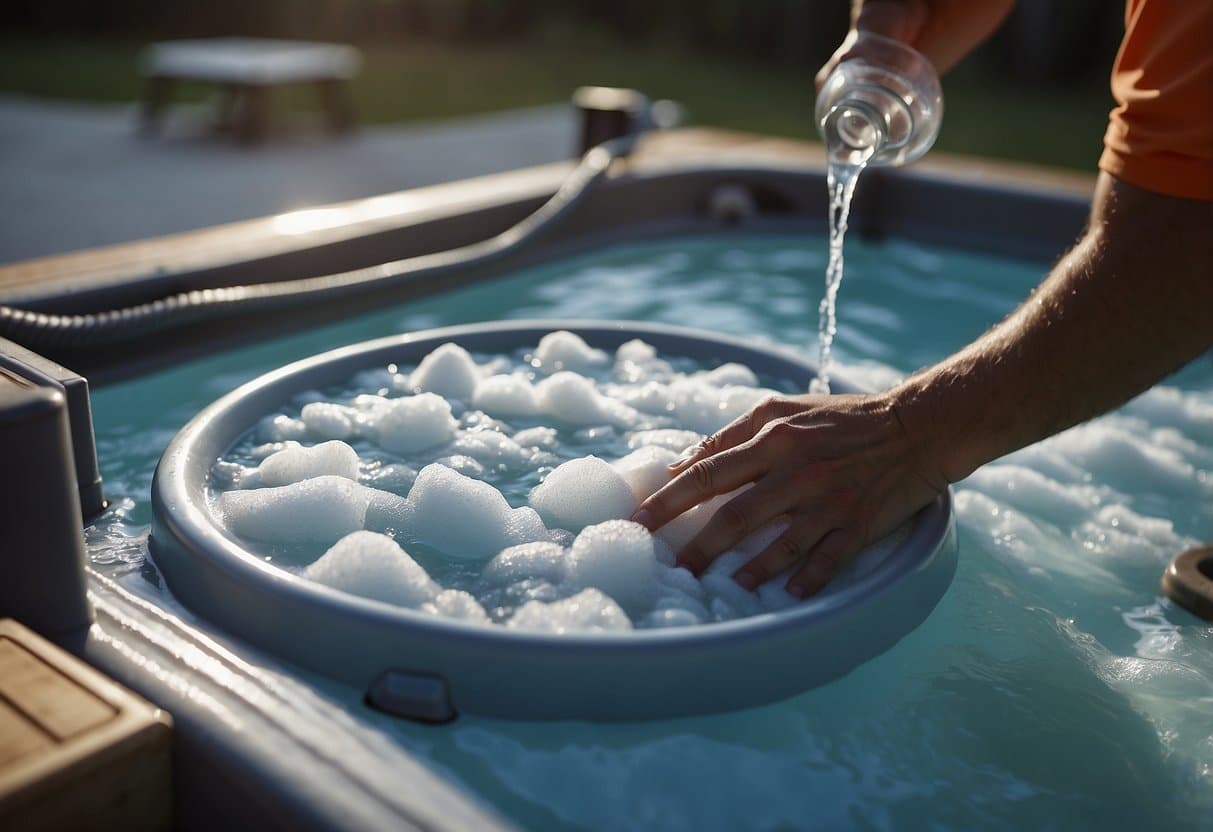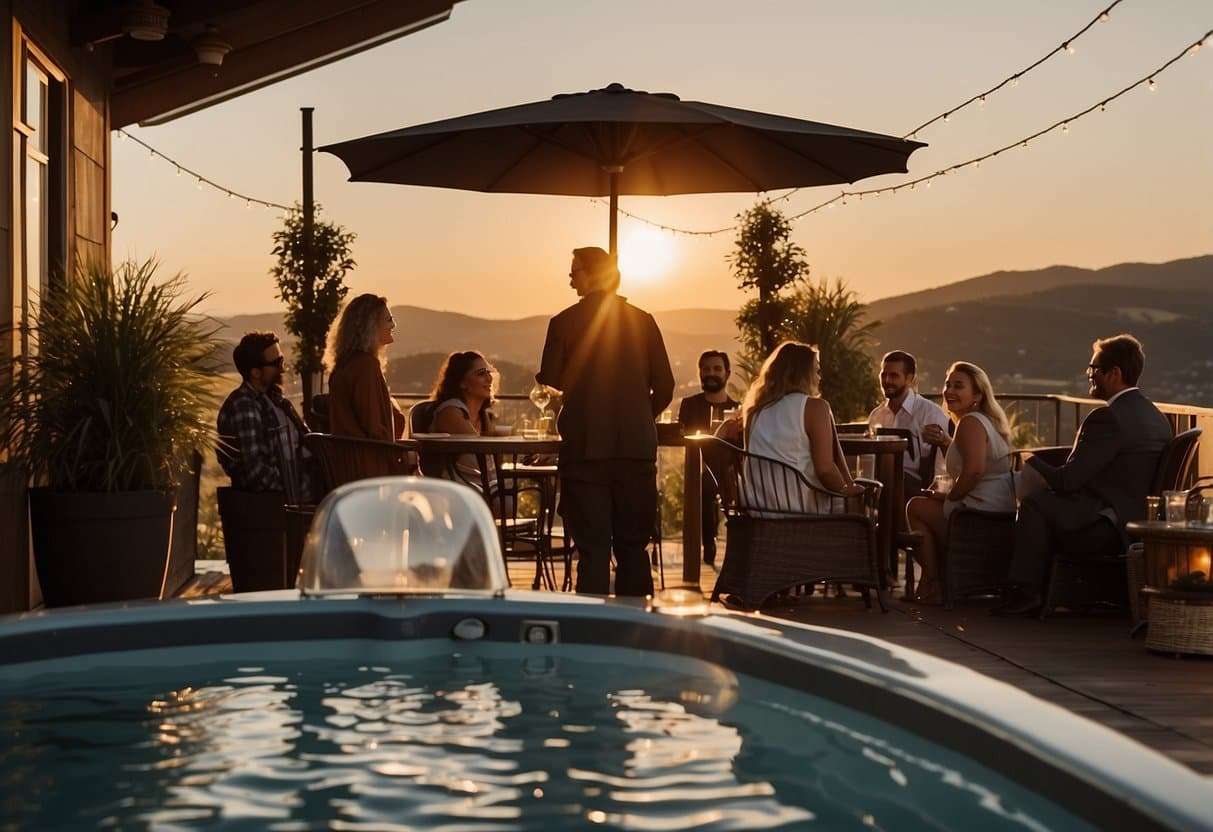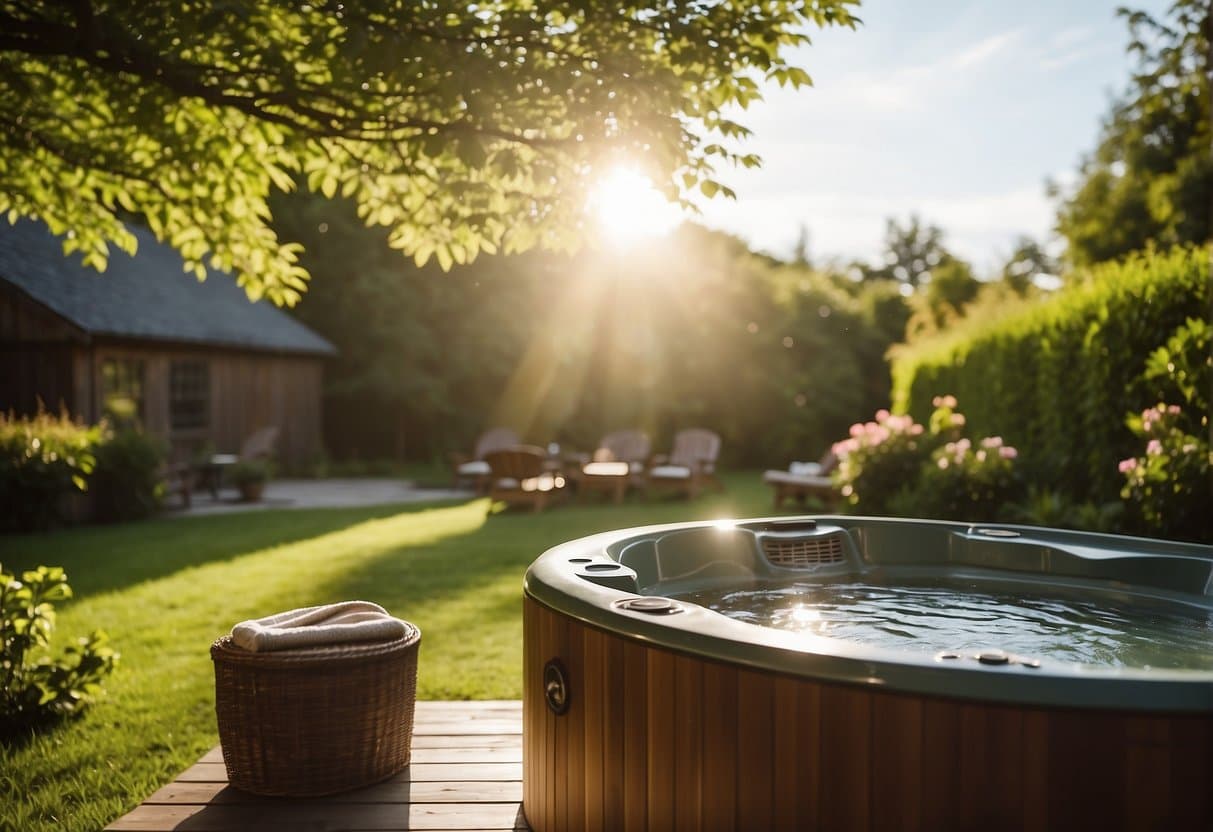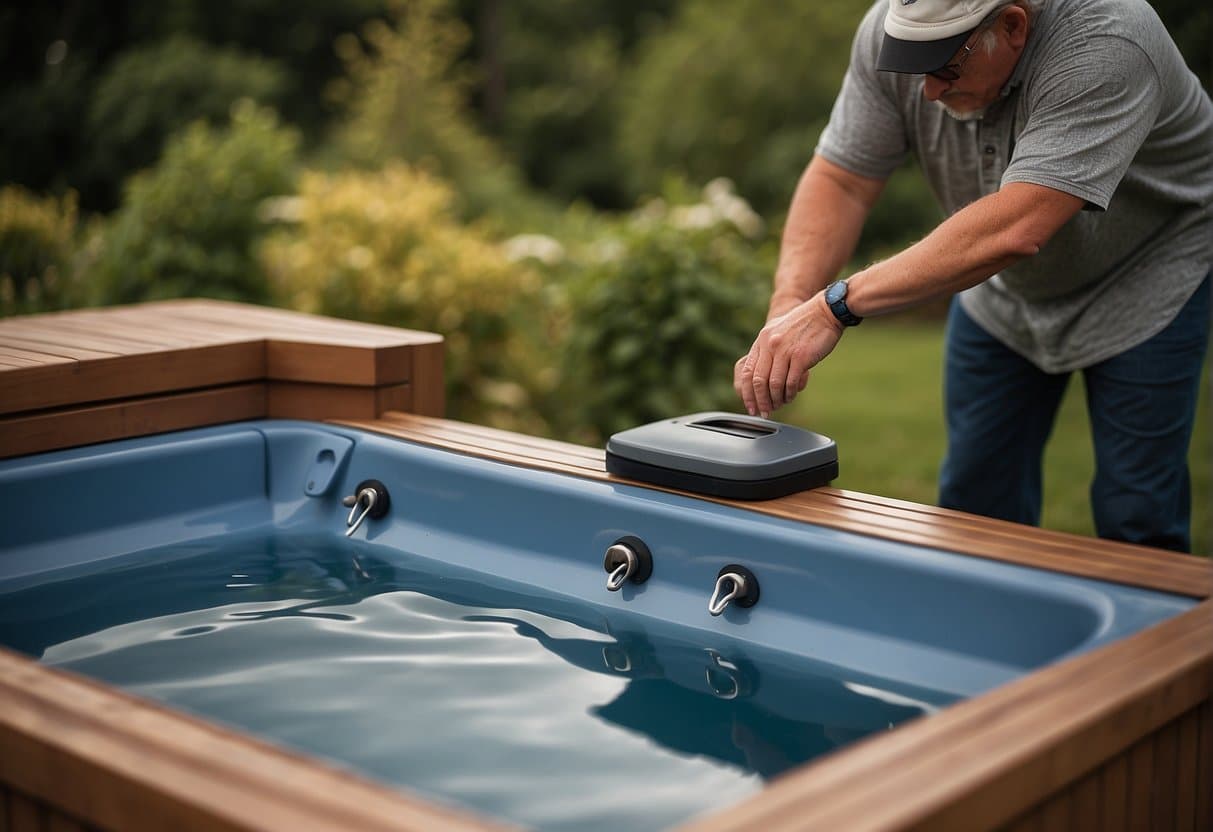The thought of buying a hot tub is exciting but can be confusing at the same time. A hot tub is a great addition to any home; however, without the proper research, your new investment can add stress instead of taking it away.
Though the prospect of having your own personal relaxation getaway is something to look forward to, making decisions about models, features, and reputable companies can create some buyers’ hesitation.
Thankfully, we at Canadian Home Leisure are experts in hot tubs and leisure products. Here is the complete guide to purchasing the best hot tub for your personal needs. Want some industry insight on buying a hot tub? Read this article: How to Get the Best Deals On a Hot Tub
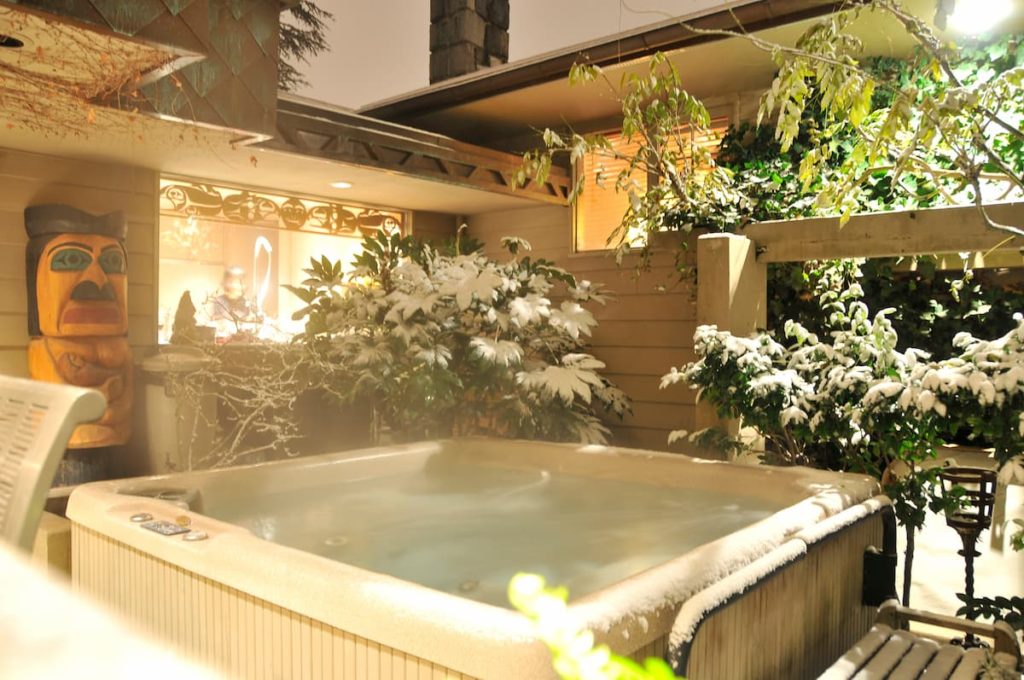
Why buy a hot tub?
Hot tubs are also a great investment for those looking to treat physical ailments. The warm temperatures and motion provided by the jets can help sports-related injuries to arthritis.
Hot tubs are also fantastic social events that can add another dimension to hosting a party or just having friends and family over for some leisure time.
19 factors to consider when buying a hot tub or spa
- Size
- Price
- Build and Quality
- On-board features
- Location
- Warranty
- Good dealership
- Design/Aesthetics
- Energy Efficient
- Indoor VS. outdoor spa installation
- When Is the best time to buy a hot tub?
- How to Choose a Quality Hot Tub Cover
- Essential hot tub accessories for your first spa
- What is involved in a hot tub installation?
- How much will I pay for hot tub running costs?
- Hot tub decks: Design blueprints and requirements
- Backyard hot tub ideas: The bold and the beautiful
- Hot tub design tips
- Can I buy a used hot tub?
The size of your hot tub
Hot tubs come in a wide variety of sizes from tiny two-seaters to pool-sized eight-seaters. Prior to purchasing a home spa, decide what its main use will be. The number of users you plan on having in your spa at once is a key factor in deciding how large it will need to be.
How many people do you intend to accommodate with your hot tub? Are you looking for an intimate, two-person hot tub or are you thinking more along the lines of the Roman baths and the more the merrier?
Related reading: Small Hot Tubs: Do I Need a large hot tub?
Take into consideration the space limitations of your backyard and your social activity/ hosting habits. If you plan on entertaining frequently, the largest size for your space limitations may be the best option for you. On the other hand, if you’re comfortable with 4 of your closest friends and family sharing a spa, our 4-person hot tub might suit your needs best.
Click on one of the following to view our options:
Price: How much does a hot tub cost?
The average hot tub runs a little under $10,000. You need to factor in the upfront investment as well as the cost to maintain and power your hot tub year-round, which can run you a little south of $100/month.
There are hot tubs out there for $4,000 all the way up to $20,000 and everything in between. Now, before you get too excited about this addition to your outdoor space, create a realistic budget for how much you can spend on the hot tub. Make sure to consider both short and long-term costs.
Short-term costs obviously include the cost of purchasing the spa itself and any work required to prepare the chosen space for its arrival (this can include installation of electrical outlets or proper flooring for the spa to sit on).
The costs associated with regularly maintaining your hot tub are examples of the long-term expenses that you should expect to incur as a spa owner.
Build and Quality
What material should you go with? Tubs today are made from two materials in most cases; wood or fibreglass-reinforced plastic.
When tubs are made from wood they are usually made from hardwoods like cedar, redwood or teak which are all capable of handling the presence and effects of water well and these are more traditional-looking.
Plastic tubs are lighter, they tend to leak less than their wooden counterparts and more often are able to have more comfortable seating and seating options.
Related reading: Want to Run a Natural Chemical Free Hot Tub?
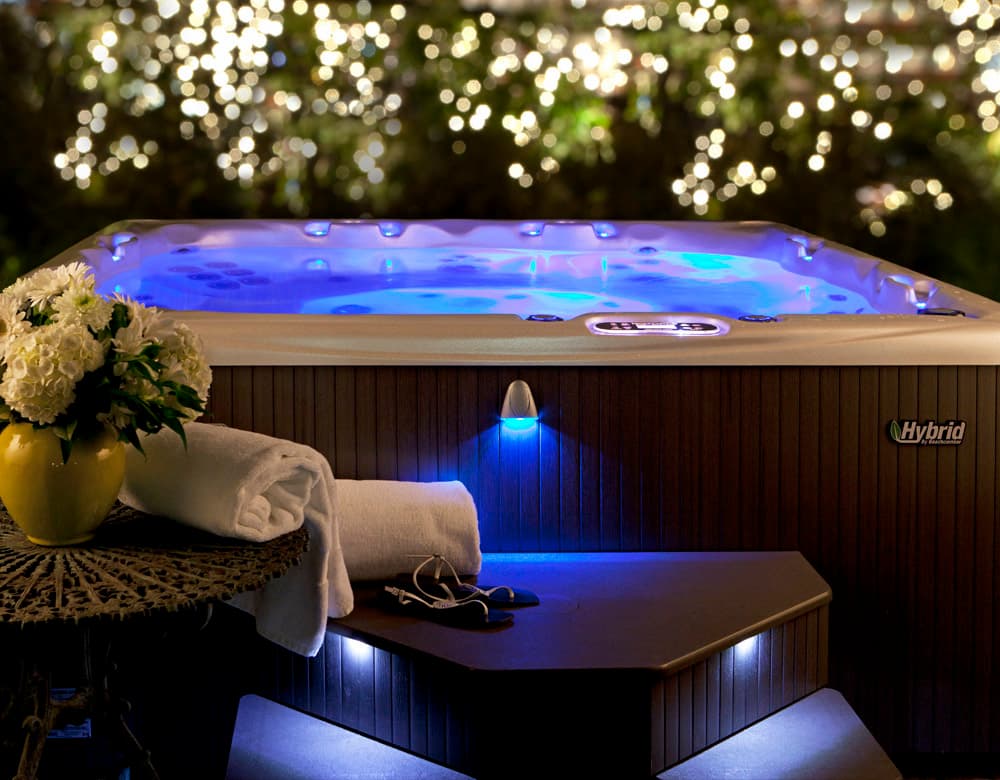
On-board features
Not every spa comes equipped with the same features. Hot tub technology is always making advances.
You can purchase amazing add-on features such as mood lights, waterfalls, music systems, a dozen different kinds of jets and more for your hot tub. Choose features that you find necessary and/ or exciting that will make you enjoy your hot tub all the more.
Rank quality over quantity. For example, a more efficient heater will reduce the monthly cost of maintenance and extend the spa’s life.
Of course, features align closely with the price. Warranties fall into this category, too. Know how well-protected your purchase will be and for how long.
Location
When finding the right spa for your home, first determine where it will be located on your property. You will need a stable surface with access to electrical outlets. It’s also important to purchase a hot tub that complements your outdoor space. The amount of available backyard space can limit how large your spa can be.
Warranty
Unfortunately, with any purchase, there’s always a risk for something to go wrong or break. If this happens, you’ll need immediate maintenance for your hot tub so getting a good warranty is absolutely essential.
Reputable manufacturers will carry lifetime warranties for the hot tub shell and many years of coverage for the electrical and mechanical components. Be sure that you get sufficient coverage for your hot tub choice.
Good dealership
If possible, buy your hot tub from a certified dealership. Refrain from online and auction-style stores. The bargains may seem enticing, but the product rarely delivers as expected.
Physical spa shops offer customer support, recommending hot tub care products and practices. This will help immensely in the months that follow your purchase.
Design/Aesthetics
Admittedly, how the hot tub looks will influence your decision. That said, where your hot tub sits can make a dramatic difference to its appearance. For this reason, plan where you want the hot tub to go in advance.
Measure accurately, considering the permanency of its location. For example, the landscape or desk space surrounding it. Locate electrical outputs, too, as you’ll need to power its jets and appliances.
When measuring the size of your hot tub, understand how far the square footage will go. In other words, the maximum capacity of the hot tub and the room for stairs or trim around it. The more you investigate such details, the better chance you have of stealing a deal!
Read more about designing a yard around your hot tub.

Buy an Energy-Efficient Hot Tub
One of the things to consider when purchasing a hot tub is the energy consumption that will accompany your new home spa. If you purchase a hot tub expect to see your energy bill climb, but there are ways to reduce consumption by planning ahead.
Purchasing an energy-efficient hot tub and making use of smart ownership practices, will minimize the financial toll that a hot tub has on your home. Make sure to consider these four points when looking into the energy efficiency of a potential hot tub.
Fitted Cover and Quality Insulation
Both these points revolve around preventing the removal of heat from your hot tub. And the more your water temperature drops, the harder your hot tub has to work to heat the water. Properly fitting spa covers stop rising heat from escaping the spa. On the other hand, spas with full-foam insulation provide dense insulation, which serves to maximize heat retention.
Hot Tub Placement
A hot tub that’s sheltered on all sides or located by a house corner or tall trees, won’t lose heat as fast as one with all the sides exposed. Having barriers around your spa helps to shelter it from cold winds and retain some of the heat. So, determining the right place for your hot tub is just as important as which one you choose.
Plumbing Design
When it comes to energy efficiency, basic is best. The more diverter valves and elbows and union points in the design, the poorer the jet performance will be and the more piping the water has to travel through. This allows for more heat to be lost as the water is cycled through the system.
Light
Many hot tubs make use of lights on the exterior or inside the tub. Depending on the type of bulb being used, the amount of electricity that’s drawn varies. For instance, LED bulbs are much more conservative with their energy use than incandescent bulbs.
Indoor VS. outdoor spa installation
Many things differentiate hot tubs on the market. Although features and design individualize some models, there are broader differences to consider. For instance, the intended environment for the spa.
Some hot tubs are portable, suitable for families who move around or feel tight on space. Others are permanent fixtures in homes and backyards. For many shoppers, the decision of where to put a hot tub boils down to an indoor versus outdoor installation.
Indoor Hot Tub pros
- Ultimate privacy
- Easy accessibility
- Less maintenance
Indoor Hot Tub Cons
- Potential risk to woodwork, structure, walls (paint and insulation), and floors
- High ventilation demands
Tips on Preparing for an Indoor Spa
For indoor spas, the ground floor promises the greatest structural support. After all, some hot tubs exceed 5,000 pounds once filled. Pushing a hot tub through doorways and upstairs also poses a challenge. You may find the ground floor most convenient.
Regardless of where in the house, consider drainage and power. Spas often demand more electricity than is available through conventional outlets. Moreover, the environment must be protected against spillage, leakage, and moisture. How much water escapes the bathtub is small in comparison. Not to mention, the steam generated is more extensive than a long shower.
Good ventilation will help reduce the threat to your home’s interior. However, it will not keep the spa room safe from water damage. For this reason, tile the floors, ceilings, and walls. The humidity is greater than in a typical bathroom, so you may need to remodel aspects of the room accordingly.
| Outdoor Hot Tub Pros | Outdoor Hot Tub Cons |
| – Asset for property value – Beautiful deck and landscape opportunities – More space | – Substantial installation if without a proper foundation – By-laws and other municipal regulations – Greater maintenance and risk of damage by the elements |
Related reading: Can I put a hot tub in my house?
Tips on Preparing for an Outdoor Spa
Like in the house, an outdoor spa requires extensive structural support. Not all landscapes are level, so flattening an area is a necessary first step. But keeping the foundation strong with concrete and other durable materials can add to the cost of a spa. All things considered, don’t mistake this as an argument that indoor spas are cheaper.
Position your outdoor hot tub away from other water sources like eavesdrops and irrigation systems. Although a water unit, excessive moisture can lead to mildew, rust, and other problems. If possible, keep the spa shaded by aligning it close to the home or under a gazebo. Light can fade the exterior and burn the surface leather much like our own skin.
A good distance from the home is about ten feet. From this distance, the spa can connect with power panels without extension cords. Anything closer may intrude on the flow of traffic in and out of the home. It may also make things harder to clean!
When Is the best time to buy a hot tub?
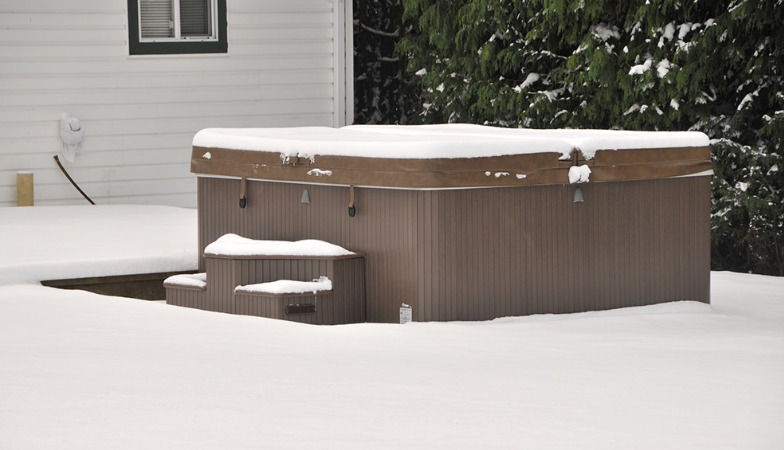
The most popular time of year to purchase an outdoor spa is the early spring. It leaves ample time to prepare for summer—a time suited for outdoor living.
Conversely, purchasing a spa in the fall presents a sanctuary from the impending snow.
Arguments for or against hot tubs are possible year-round. So what other factors need weighing?
Installation
Have you prepared a space for your new hot tub? If not, plan for landscaping or construction. Furthermore, consider the environment you wish to cultivate around your spa. The spring offers mild temperatures and fecund yards.
Usage
The right time to buy a hot tub hinge upon how you intend to use it. If it will serve as a winter getaway, then get one in the fall. If you like to host parties in the summer, then shop around in the spring. That said, you needn’t always be a season ahead.
Budget
Only you will know when you’re financially ready to buy a hot tub. Nevertheless, sales along the way might help you afford one sooner. Sometimes, the best time to buy is when the price is right.
More often than not, the New Year brings great cost reductions. As the fiscal year turns towards its end, businesses look to ramp up sales and sell inventory.
Real Estate
An outdoor spa is not a small investment. So you must assess your plans to move and how a new hot tub fits in. Calculate the cost of relocation and the effect of a spa on home value. Depending on how far you look ahead, the right time might just reveal itself.
How to choose a quality hot tub cover
Hot tub covers are essential accessories. They conserve heat, reduce operational costs and maintain adequate chemical levels in the spa. Not to mention, they stop leaves and other outdoor debris from falling into the water.
An average cover lasts between four and five years, depending on its usage and quality. To get the most years from a cover, evaluate the three criteria below before purchasing it.
- Foam Core
- Reinforcement
- Vinyl Quality
1. Foam Core
How well hot tub covers retain heat depends on three things:
- foam density
- foam thickness
- foam sealant
Foam density
A 1.5-pound density cover will provide sufficient strength and rigidity. That said, larger spas might need upgrading to two pounds.
Foam thickness
Hot tub covers less than two inches thick will not provide enough support or insulation. Similarly, flat covers collect water and can sag over time. Covers with a two-inch slope are best, with a minimum thickness of three inches at its shallowest point.
Foam sealant
Poly wraps form a moisture barrier and prevent water from penetrating the foam. Standard poly wraps are two millimetres; never buy less than this. Additionally, check the workmanship of the hinge seal to minimize gradual heat loss.
2. Reinforcement
All covers require a reinforcing c-channel to bolster the foam and hold its form. Most channels come in aluminum or galvanized steel—the latter offering more strength.
How the cover is sewn also affects its durability. Look for products with at least triple-stitching around high-stress areas like handles, locking straps and seams.
3. Vinyl Quality
Good quality marine vinyl weighs 30 ounces or more. It will also include UV and mildew inhibitors.
For colder climates, check the recommended temperature ranges to ensure the vinyl will not crack or blister.
Most covers now include drain holes, too, that allow moisture to escape. Ensure your cover has this feature to avoid waterlogging.
Why Spa Covers Are So Important
Spa covers are imperative to preserving the integrity of your spa. From safety to hygiene, a good cover helps keep your spa in good working order. Make sure you understand how to clean your hot tub cover to extend its life.
Prevents Bacteria Growth
Without a cover, your hot tub is exposed to a variety of different sources of bacteria. For example, yard debris, insects and even rainwater will have access to the water and potentially compromise the cleanliness of your hot tub.
Provides Protection from the Sun
Extended exposure to the sun’s ultraviolet rays can cause slow deterioration of your hot tub acrylic shell, which will shorten its lifespan. A cover protects your backyard investment from those harmful rays and lengthens the life of the hot tub in the process.
Acts as a Critical Safety Measure
If you have young children or pets, such as dogs or cats, a cover is a crucial safety precaution. Although not as large as a swimming pool, a hot tub is still deep enough for a child or pet to drown. Keeping your hot tub covered whenever it’s not in use is critical to avoid a potentially devastating situation.
Saves on Energy Costs
Covers also prevent drastic temperature fluctuation in your hot tub. Without the cover, heat escapes from the water much easier, which means much more energy is required to keep the water at a consistent temperature. Not only will this raise your energy bill but it forces your spa heater to work overtime to heat your water. This can cause unnecessary wear on your heater components, resulting in them having to be replaced sooner.
If your hot tub’s cover isn’t in good working order or you don’t even have one, here are some of the top reasons to invest in one. Take care of your investment so you can enjoy it for years to come!
Essential hot tub accessories for your first spa
On its own, a hot tub can provide hours of enjoyment and relaxation. From kicking back alone to hosting spa parties, it’s the ultimate leisure activity. Yet many spa owners feel the tub is not enough. They prefer adding accessories to improve their ambiance or make maintenance easier. So here are a few essentials to consider at the store!
Spa Steps
Aboveground spas can be hazardous to enter. For climbing in, buy a set of steps that allow bathers to sit, twist and lean on the ledge safely.
Test Strips and Chemicals
Hot tubs require weekly maintenance to keep the water clean and balanced. Products you will need to refill include sanitizers; shockers (i.e. bromine and chlorine); alkalinity, calcium and pH risers; water clarifiers and more.
Covers and Floating Blankets
Investing in a good cover can do wonders for your tub:
- It reduces energy consumption by regulating the temperature;
- It keeps debris and dirt from contaminating the water;
- It protects the interior components from unnecessary damage and weathering.
Covers work well between hot tub uses. For days when you constantly jump in and out of the water, you should also invest in a floating blanket. These look like strips of bubble wrap that can temporarily provide the aforesaid benefits.
Water Vacuums and Nets
Inevitably, things will fall into the water—bugs, food, leaves and more. Having a tool to quickly remove them can help you maintain water balance and improve hygiene.
Pillows
Many spa shops sell inflatable pillows. You can let your pillows float or mount them with suction cups where you sit.
Speakers
Installing speakers in your hot tub can cost a small fortune. As well, it limits their use. Instead, look for cordless speakers on your deck or surrounding patio. That way, you can listen to your music in or out of the tub.
Filter Cartridges and Cleaners
Your jets and filters need replacing over time. By cleaning them regularly, you can increase their lifespan. Therefore, keep stock of both filters and cleaners for your routine checks.
Lights
Underwater lights can add to the allure of a spa, particularly at night. They also help bathers get in and out of the tub safely.
What is involved in a hot tub installation?
Installing a hot tub takes no time at all. For most homeowners, all the work comes before its delivery. Hot tubs need sturdy foundations and easy access to electricity.
Municipal permits and restrictions
Depending on your city, some municipalities require permits that specify restrictions such as:
- The spa must clear the home and property line by at least five feet;
- The spa must be at least ten feet from overhead powerlines;
- The spa must sit at least five feet from the electric panel.
Proximity to a water source
In addition to the bylaws, you must consider the proximity to your water source. If connected to the home, anything further than 50 feet will result in inadequate pressure. Likewise, if you must fill and drain your tub with a garden hose, it needs to be close to the bib.
Proper concrete foundation
Once filled with water, a hot tub weighs thousands of pounds. For this reason, all tubs need a concrete platform to keep them level. If you plan on building a deck, it must be professionally constructed and certified to support such weight. Even still, some hot tubs are just too large for backyard decks and will need to be placed underneath.
The electrical components of a hot tub
For most hot tub installations, there is no plumbing involved. That said, you will need to deal with wires and electric panels. Spas use outlets of 240 volts or more, which requires you to contact a professional electrician for this part of the installation. The high voltage involved is far too dangerous to tamper with.
After the electrician hooks up the spa, keep the power off a little while longer. You should first clean the jets and interior and open the air valves. Only once cleaned can you fill the tub with water and chemicals. Afterwards, flick the switch and wait for the water to heat!
How much will I pay for hot tub running costs?
The price of electricity varies, making it difficult to calculate how much hot tubs cost extra in utilities. Some hot tubs require more energy, just as some regions charge differently for electricity. Ultimately, the amount you can expect to spend on hot tub running costs depends on your spa’s water volume, temperature and mechanical makeup.
Calculate the volume of water
How much water your hot tub holds affects the amount of energy needed to heat it. The greater the volume, the higher the costs.
Temperature
Both the inside and outside temperature of your spa affects its energy consumption.
High temperatures need more energy to maintain. Similarly, cold weather means your tub must work harder to regulate its temperature.
Indoor spas face challenges when it comes to humidity, too. That said, a good cover can reduce your electrical overhead.
Mechanics
Some models are more energy-efficient than others. Insulation plays a large role in the conservation of heat.
Electrical Outlet Installation
Most hot tub buyers worry about energy consumption and not how they will juice their spa. Some homes do not offer adequate voltages to power a hot tub and thus require new outlets.
This can be a steep upfront investment, so when calculating your running costs, consider how much electricity your spa needs and confirm your existing outlets can support it.
Maintenance Fees
Besides energy, hot tubs do require some manual upkeep. You will need to replenish and replace the chemicals, filters and pumps, which adds to your bottom line. Factor such supplies into your monthly budget.
Hot tub decks: Design blueprints and requirements
The average hot tub weighs 8000 lbs. Add six or seven adults and the weight could exceed 9000lbs. Understandably, the structure you place under your hot tubs needs sturdiness and sound engineering.
For this reason, we recommend hiring a professional deck or patio builder. But if you’re a DIY person, we’ve provided some load-bearing calculations below.
Hot Tub Deck Foundational Calculations
When designing a hot tub deck, you need to determine the size of its posts, joists and beams. To do so, calculate its minimum load-bearing capacity:
- Dry weight + water weight + maximum occupant weight = total weight
- Total weight/square footage = support load
Using the formula above, let’s pretend our hot tub weighs 1000 lbs.
It holds 2000 lbs of water and six people, averaging 185 lbs each.
The total weight of the tub comes to roughly 4110 lbs.
If its square footage is 40, then the design must accommodate 102.75 lbs per square foot of deck.
The wooden frame that you construct does not support the weight of a hot tub alone. Every spa needs a concrete slab underneath to ensure it remains level and does not sag into the ground. Typically, a 3-1/2 to 4in slab is enough.
Note that elevated decks require professional engineers to design and build. This is the law in most municipalities. There are too many variables and concerns to undertake such a project alone.
Backyard hot tub ideas: The bold and the beautiful
Hot tubs come in various shapes and sizes. How you fit one onto a property depends on the landscape, power supply, privacy, and more. If unsure which tub suits your home best, here are a few creative spa installations to generate ideas.
The Pool & Spa Combo
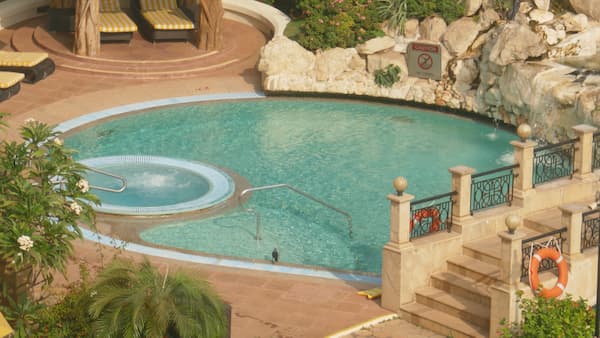
Embedding a spa within your pool is a gorgeous way to consolidate water property. Most homeowners who adopt this design add the hot tub to the shallow end. Doing so conserves space by sharing the stone perimeter of the pool.
A Secret Spa Enclave

Nestling a deck and spa into an enclosed area ensures the utmost privacy and serenity. Underground spas intrude less on the surrounding space too. They make it easier to decorate the surrounding area with furniture.
The Gazebo
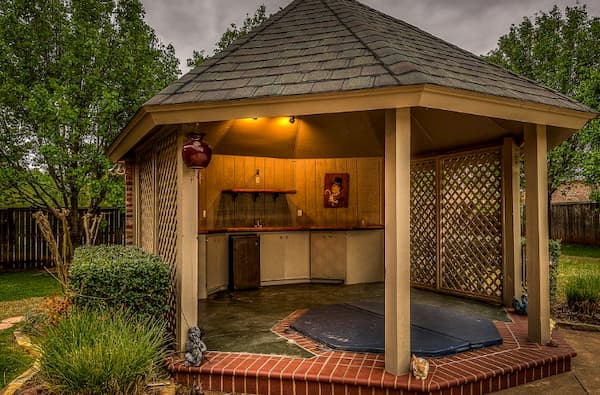
Gazebos offer some privacy and protection from the weather. You can enjoy sheltered spas in a rainstorm or in the heat of a clear afternoon. Plus, gazebos protect spas from snowfall, debris and sunlight bleaching.
A Luxurious Lookout
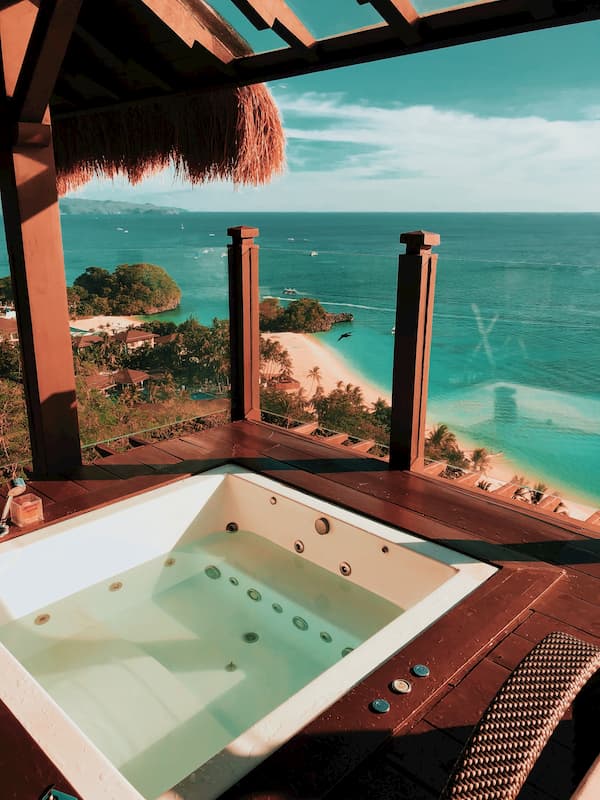
Hot tubs overlooking the property from the second storey can create jaw-dropping views. That said, they do sacrifice privacy in concentrated areas. Nevertheless, elevated spas provide easy access to rooms on the top floor. They can also circumvent the limitations of a small backyard.
Into the Wild

If you own many acres, consider constructing a spa platform far from home. In wooded areas, spas complement other camping themes like fire pits, trailers, and more.
An Easy Patio Expansion
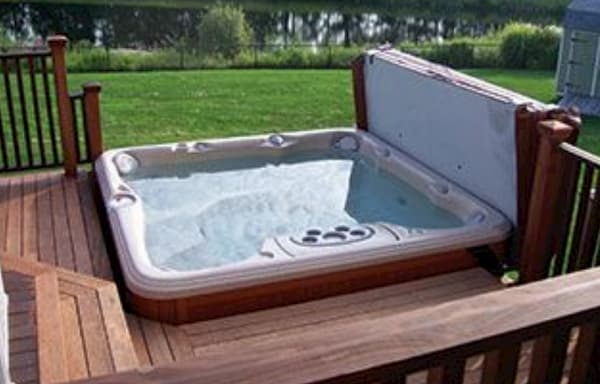
Even without a large budget, hot tubs can grace any home patio. Keeping the hot tub near the home is most convenient for cleaning, using, and powering it.
A luxurious patio expansion

Hot tub design tips
Hot tubs flush to a deck’s surface are beautifully sleek and modern. Unfortunately, for families, such designs pose a safety risk.
Similarly to in-ground pools, children can slip and fall into the spa. That said, keeping a lid locked and closed can minimize the risk.
That being said, keep your hot tub 17-14in above the deck lets bathers sit on the rim and enter/exit the water.
Regarding the position of the deck, consider the following:
- Wind direction
- Placement of trees,
- Coverage from the sun and other elements,
- Privacy.
For deck inspiration, check out the following blogs: DIY Network and Houzz or our very own article on 30 Hot Tub Deck Ideas to Relax to the Max
Can I buy a used hot tub?
In an attempt to save money, you may consider realizing your hot tub dreams by purchasing a used hot tub; however, taking this avenue may not have the desired result. Here are some reasons that you may want to rethink purchasing a used hot tub.
Spa Quality
Unlike a house, hot tubs have a shorter lifespan–quality hot tubs will last approximately 15-20 years. You can extend the life of your hot tub with regular and routine maintenance. A used hot tub can have wear and tear preventing the equipment from functioning optimally.
Related reading: Hot Tub Maintenance Checklist
Reputable Seller
Unlike when you’re purchasing from a hot tub dealer, many used hot tubs are sold by other people looking for others interested in a home spa. In this scenario, it’s hard to guarantee that the individual has properly up kept the hot tub and performed the required maintenance on it.
If you still want to pursue the route of a used hot tub, try finding a dealer who sells them. Dealers have a reputation to sustain and are less likely to sell a poor-quality unit. Also, consider buying from a close friend or family member you can trust. And prior to purchasing a used tub, remember to test it to confirm everything works (i.e., heater, jets, etc.)
Benefits of Purchasing a New Hot Tub
Warranties
New hot tubs come with a warranty that covers the tub and any repairs that need to be done should something break during the warranty period.
Professional Delivery & Installation
Properly setting up your hot tub is extremely important. Any mishandling during the installation can damage your hot tub. At Canadian Home Leisure, we are proud to offer our customers professional delivery and installation.
More Selection
With used hot tubs, you’ll notice your selection is much more limited. This selection is likely to become even smaller once you’ve eliminated non-reputable sources. Entrusting your spa needs to a dealer opens you up to a wider selection and more updated models.
Make your spa purchase an enjoyable investment
The purchase of a hot tub can seem daunting but in the end, the benefits of your purchase will far outweigh any concerns you may have now.
Get educated.
Know what you’re looking for BEFORE going into a dealership and get the hot tub that’s a perfect match for your needs.


